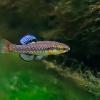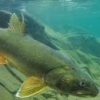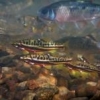I worked in a lab for 5 years that bred Bluefin killifish and I did an experiment with them that required me to get their eggs. They are really easy to breed. They were on a 12L:12D light cycle or maybe 14L:10D cycle. We never checked water temperatures but it was around 70-80 F. We used spawning mops made of yarn and put some on the bottom of the tank and some floating at the top, but it shouldn't matter if you only had one position (they laid eggs in both). We've used tanks as small as 10 gallons and as large as 30. We've done it in pairs or in larger groups and it didn't matter, although I would recommend keeping them at a roughly even sex ratio (if it's not 50-50, I would put in more females than males). Bigger males and females are best.
They WILL eat the eggs, so if you're looking for lots of eggs then I would recommend checking the spawning substrates and removing the eggs within 1-2 hours after the lights come on. There is also definitely a little of a seaonality effect, even if they aren't exposed to natural light. The main egg production was from about April - October, although they do breed year round (might just get less eggs on any given day).
If you have questions or want more information feel free to PM me.











